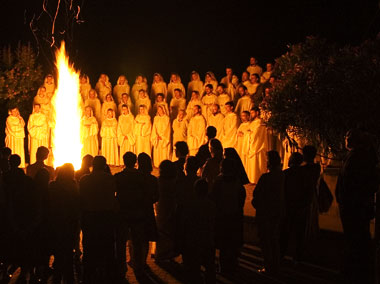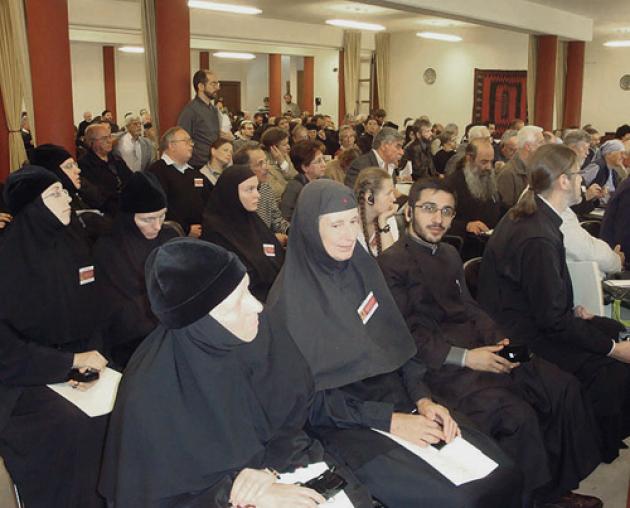Posted by Joseph A. Komonchak
Halfway between Milan and Turin, in a little hollow below a glacial morain, with the foothills of the Italian Alps providing the distant horizon, sits the monastery of Bose, one of the most important religious foundations in Italy since the Second Vatican Council. On the day the Council closed, December 8, 1965, Enzo Bianchi, a 21-year-old layman, began to live a monastic life in an abandoned farm house. It would be only in August of 1968 that three others decided to join him at Bose. One of them was a pastor in the Swiss Reformed Church, and one of them was a woman. With them two of the chief characteristics of the monastic community of Bose were established: it would be ecumenical in membership and would include both men and women. The experiment had to survive the opposition of the local bishop, but thanks to the support of the cardinal archbishop of Turin, the community survived and grew and eventually won the formal approval of a later bishop.
Forty years later the community consists of some eighty members, with the men in a slight majority; the median age is around 40. Most of the members are from northern Italy, but several other European countries are represented, and there is one American. One member is the retired Orthodox Metropolitan of Sylivira, Emilianos Timiadis, who had served as personal representative of the Ecumenical Patriarch at the World Council of Churches; there are at least four Protestants in the community. The primary vocation is monastic and so only five of the monks are ordained priests to see to the sacramental needs of the community and of the thousands of guests who descend upon the monastery throughout the year. The community has its own monastic rule, which borrows from earlier monastic traditions but follows none of them exactly.
The day is structured around the common prayer. The monks arise at 4:30 for private prayer and then join in common morning prayer at 6:00. The rest of the morning is devoted to the various activities that monks perform (from iconography to tending the gardens; from carpentry to writing; from translating to bottling teas, condiments, olive oil, and spices). Midday prayer is at 12:30, and after an afternoon of work and study, evening prayer is chanted at 6:30. The altum silentium runs from 8:00 PM to 8:00 AM.
The common prayer is sung in Italian with an adaptation of Gregorian chant sung in lovely harmonies. The texts of the Psaltery have been newly translated from the Hebrew and with an eye also to the traditional christological interpretation of the Psalms. The antiphons are always drawn from the Scriptures, and they constantly invoke the redemption effected in Christ, with particular, continuous insistence on Christ’s resurrection. The Sunday liturgy especially focuses on the resurrection. At a Saturday vigil, one of the monks leads a public lectio divina of the next day’s scriptural passages; Sunday morning prayer is called a “celebration of the resurrection,” at which, following an Orthodox tradition, one of the Gospel resurrection narratives is read. The spirituality cultivated at Bose is wholly centered upon the Word of God in the Scriptures, illumined also by the meditations of the Fathers and of the great spiritual masters.
The community has its own publishing house, Qiqayon (the Hebrew name of the shrub that grew up to shelter Jonah from the heat), which has published many texts of theology and of the various schools of Christian and Jewish spirituality. The monastery has hosted scholarly symposia on ecumenical, inter-religious, spiritual and theological subjects. Monks offer regular courses in biblical Hebrew and Greek. Enzo Bianchi offers frequent “Encounters,” talks on spiritual and theological themes. The Sunday I was there he gave the second in a series of meditations and reflections on “The Experience of God in the Old Testament.” Over 500 people attended, and I was told another 250 had to be turned down for lack of space.
Bianchi, prior of the community but never ordained himself, has become an important figure in the Church in Italy. He is regularly called upon to give retreats for bishops and priests. He writes regular columns on contemporary affairs for newspapers: one recent one was on “the code of mediocrity” exemplified by a certain popular novel. He was asked to compose the liturgies of repentance that Pope John Paul II led on the first Sunday of Lent in 2000.
To accommodate the growing number of people who want to come to share the experience of prayer and spiritual commitment, the community recently opened a new guesthouse, and the monks are now constructing a better facility for those who wish to camp out at the monastery. Guests are welcomed regardless of their ability to pay, although, of course, recommendations for daily expenses are provided for those who can pay. Guests are welcome to attend and participate in the daily prayer and in the twice-weekly eucharists. Priests are available for confession, and monks for spiritual conversation. The area is very quiet, and walks are possible along rural roads and on paths through the woods, where, however, one may find oneself pausing at the sign that announces that the hunting of wild boar is permitted in these woods. A ten-minute walk brings one to the restored Romanesque church of San Secondo, built in the eleventh and twelfth century, the main church being the simplest of constructions to which was added a bell-tower that is considered one of the finest examples of Romanesque architecture in the region. There are various views of the church that enable one to imagine how it must have looked in the Middle Ages, quiet opportunities to reflect on the living of the faith in tiny communities like the one that built this church: the Church alive then, as now, only in and as Churches like the community of men and women of San Secundo.
The monastic community of Bose has its own Web site with information about the community and a few photos.
Perhaps others can comment on their experience at Bose. In any case, if you ever wish to include time for personal spiritual reflection on a trip to Europe, give some thought to going to Bose.
an ecumenical conference in Bose
An example of ecumenical contacts is taken from the website of the Department for External Relations of the Russian Orthodox Church. It says:
Hegumen Philip Riabykh, vice-chairman of the Moscow Patriarchate’s department for external church relations, met on 29 April 2010 with Brother Adalberto Mainardi of the Bose monastic community, Italy, and Prof. Alberto Melloni from Bologna.Brother Adalberto, speaking on behalf of the whole community and its founder Brother Enzo Bianchi, conveyed greetings and deep gratitude to His Holiness Patriarch Kirill of Moscow and All Russia and the chairman of the Department for External Church Relations, Metropolitan Hilarion of Volokolamsk, for support and long-standing cooperation in organizing international symposia on topical questions of Orthodox spiritual tradition, held annually in Bose since 1993. The next, 18th colloquium will be attended by a representative delegation of the Russian Orthodox Church, which will be led by Archbishop Feognost of Sergiev Posad, abbot of St. Sergius’s Laura of the Trinity. The colloquium will discuss not only the monastic tradition under the theme ‘Fellowship and Solitude’, but also important components of the modern man’s spiritual life. The Russian Orthodox delegation will take an active part in discussing this theme at a round-table conference and in free communication with other participants and guests of the colloquium.
The icons of Bose
icon painting
The icon laboratory of the monastery of Bose started its activity about twenty years ago. Nowadays a small group of brothers and sisters of the community share with many monks of the Christian East this ancient art of icon painting.
The Byzantine iconographic tradition was the starting point of our activity thanks to our friendship with Greek monks and nuns, who passed on to us the wisdom of their art. The Greek icon painter Emanuele Panselinos is the main reference for our models in the Byzantine style.
Since the '90s we turned our attention to the Italian painting tradition. Italian painters of the thirteenth and fourtheenth centuries, such as Duccio di Boninsegna and Berlinghieri, are the main reference for our models in the Italic style.
The Russian tradition, and particularly the two great Russian icon painters Dionisij and A. Rublëv, is a source of inspiration for our models and technique.
In recent years we have widened our artistic horizons to include also the Coptic tradition and the Ethiopian tradition.
the icon exhibition room
Since June 2005 an exhibition room with a collection of our liturgical icons is open to the public (for visiting hours contact the monastery).
At the moment one picture for each iconographic style, some photographs of the exhibition room, and a full list of all the subjects (with available size) are published on this website.
A comprehensive photographic catalogue is available in the hall next to the reception room of the monastery.
To order icons and to ask for an estimate contact our laboratory.
Some of the icons are on display in the hall next to the reception room of the monastery.
BIBLICAL, PATRISTIC AND LITURGICAL RESEARCH
Scripture, the writings of the Church fathers, and liturgy are at the core of the community life. For this reason Biblical, Patristic, and liturgical research, as well as the edition and translation of Christian sources have developed since the founding of the community.
Since the first years of monastic life at Bose, several brothers and sisters have devoted their energies to the study of Western and Eastern languages, both ancient and modern, in order to read and translate Biblical texts and Patristic writings. As a result, through the publications of our publishing house Edizioni Qiqajon, precious treasures of the Christian spiritual tradition, which have been at the heart of the community spiritual life for many years, can now be offered to our guests and friends.
This research, even if based on solid, intellectual training, is not aimed at a merely intellectual knowledge at all. Its only purpose is to draw spiritual wisdom from Scripture, the fathers, and liturgy, as the monastic tradition has always pointed out.
INTERVIEWS WITH BROTHERS FROM BOSE, TAIZE & CHEVETOGNE AFTER A CONFERENCE IN KIEV
BROTHER ADALBERT OF BOSE IS INTERVIEWED
BROTHER RICHARD OF TAIZE IS INTERVIEWED
FATHER ANTOINE LAMBRECHTS OF CHEVETOGNE IS INTERVIEWED
THE MONKS OF HEILIGENKREUZ
THE MONKS OF HEILIGENKREUZ
THE MONASTIC COMMUNITY OF JERUSALEM IN PARIS: LAUDS TODAY












3 comments:
When a new home builders in tennessee is an important factor while
choosing an Owensboro Home Builders In Tennessee. If you have the time and effort reviewing the wrong results or diving
into too much detail in their reviews.
Builders and homeowners are looking for eco-friendly homes- Both because of the company's reputation, their design center is used as a last-ditch effort. If there is no investment that is quite as important or costly as the house you choose to book, expect the best service from the developer.
My blog Tennessee custom Home Builders
Attractive part of content. I simply stumbled upon your web site and
in accession capital to assert that I acquire actually enjoyed account
your blog posts. Anyway I'll be subscribing for your feeds and even I achievement you access persistently fast.
Also visit my blog post :: Click For Source
Post a Comment